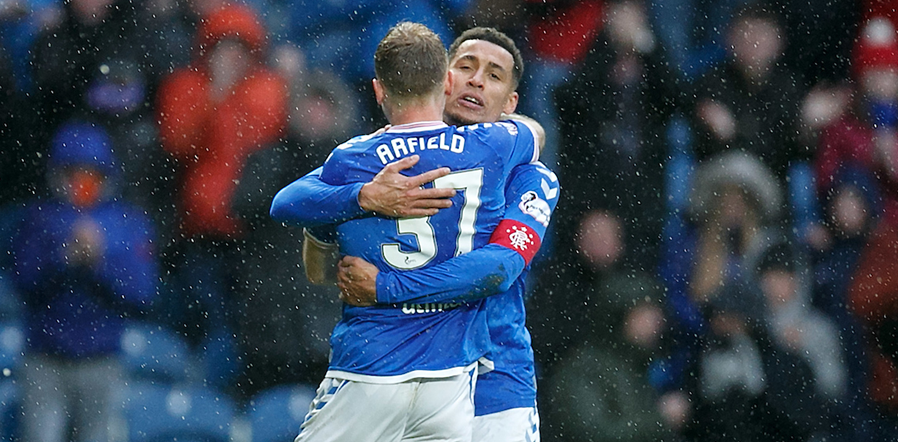It’s February 2021 and Rangers have all but sewn up their 55th league title and first in a decade.
It wasn’t really supposed to be as straightforward as this, was it? When it did come, I think most of us were expecting a nail biting finish full of twists and turns akin to seasons 2003 and 2005. After all, it wouldn’t really matter how it was achieved, what matters is that Rangers just need to win one title back and – as experts suggest – the pack of cards could come tumbling down.
In the space of just 32 months Steven Gerrard and his coaching staff have completely transformed Rangers fortunes both on and off the pitch. From a tactical perspective, this is no fluke as the current Rangers team is a well oiled technical monster. What we are witnessing is the culmination of a philosophy that has gradually evolved since that day in early May when Gerrard was annouced as manager and we were told “Let’s Go”.
In this, the third part of a mini-series written in conjunction with Gersnet and 4th Official, we’ll analyse six key games from Gerrard’s first two seasons which help to tell the story of the dramatic improvement from the team inherited in summer 2018 to the one that now stands on the brink of delivering that success we as fans badly crave.
You can find the two other excellent articles, the first by RickyBobby1872’s here and the second by Kenny here.
You’ve got to go there to come back as they say, so let’s go.
Hibs 5 – 5 Rangers 13th May 2018
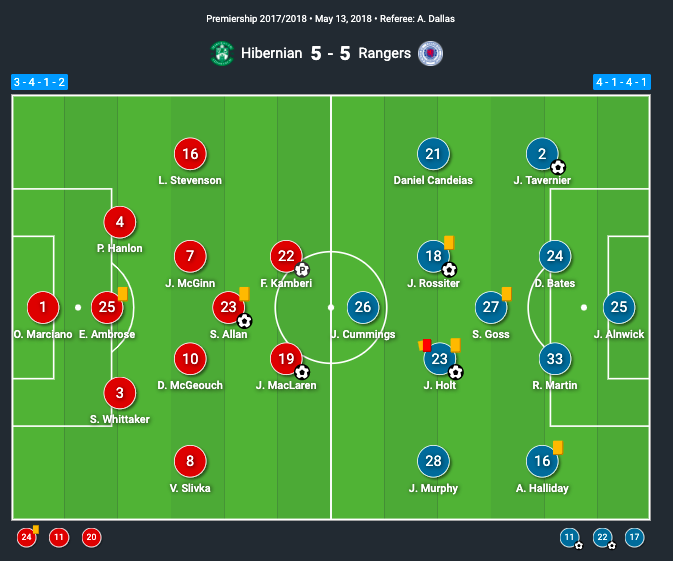
Alnwick, Tavernier, Halliday, Bates, Martin, Holt, Rossiter, Goss, Candeias, Murphy, Cummings.
It doesn’t look great does it? A game that ended more than one era and in more than one way, this was the last game before Gerrard took control and promised to relaunch Rangers. The next game – a 2-0 win against FC Shkupi in the Europa League first qualifying round – was less than 3 months later on the 12th July 2018. James Tavernier, Jamie Murphy and Daniel Candeias were the only survivors in the starting eleven.
Those first two years back in the top flight had been punishing in more ways than one but as Rangers limped to another third place finish in the league – three points behind Aberdeen and 12 behind Celtic – it was difficult to see any ray of light. The defeats to Celtic were crushing and demoralising but not hugely surprising given the vast technical and financial disparity between the two teams. There was no excuse, however, to not be comfortably finishing second in what should have been a two horse race. Under the stewardship of Graeme Murty, Rangers had been turned into a team who could be good on their day, but simply lacked the quality on the pitch to really make any waves.
Murty’s Rangers elected to play in a fairly basic 4-2-3-1 shape predicated on getting balls wide and attacking at pace on the counter. In Tavernier, Jack, Morelos and Candeias Rangers had players who would go on to be successful with the club but required tactical structure and on-pitch support. 50 goals conceded in 38 league games tells its own story about how much control Rangers had in this season.
Game 1: Twin Number 10’s – Rangers 3 – 0 Hearts 3rd April 2019

Fast forward to almost a year later and the starting eleven for this game against Heart is unrecognisable, as is the feeling around the club. The impact of Gerrard had been huge thanks in no small part to qualifying for the Europa League group stages, an outstanding achievement in his first few weeks in the job. In the league, Rangers were not anywhere near as consistent, finally finishing nine points behind Celtic. Indeed, their best winning run of the season stood at a paltry six games and actually started in this very game when the league was over and the pressure was off.
But the progress was undeniable from that standing start. Yes, Rangers were still largely reliant on James Tavernier and Alfredo Morelos as an attacking threat, and yes both were as inconsistent as the team as a whole, but progress is never linear. The tactical approach in Gerrard’s first nine months in charge focused on a controlled 4-3-3 formation with Daniel Candeias and Ryan Kent tasked with getting wide and delivering the ball into Alfredo Morelos at every opportunity. Candeias linked very well with James Tavernier in particular, the latter starting to really come to the fore as a modern full back of considerable attacking talent.
In the game immediately preceding this one, Rangers had all but lost the league falling to a 2-1 defeat to Celtic courtesy of a late James Forrest goal. But disappointment is the nurse of wisdom, as they say. The fall out from Alfredo Morelos’ red card was a crucial factor in how Rangers progressed and would result in the first major tactical shift of the Gerrard era.
His replacement in the team was January signing Jermaine Defoe, not a bad replacement even at 36 years old but certainly not comparable to Morelos’ all action physical style. A shift in tactical approach was necessary to provide more support for Defoe who was not as adept at dropping deep to link play as his counterpart. To do this, Rangers asked their wide players to play as ‘inside 10’s’ and nominally position themselves 10 yards infield from the flanks in the left and right half spaces. Scott Arfield, a more natural central player also replaced Daniel Candeias in the team. The idea was that Arfield and Ryan Kent would be able to support Defoe better from this starting position and form a tight three pronged attack. Another key benefit of this approach was the ability to better overload the opposition defence by taking advantage of space between opposition full backs and centre backs. All of a sudden, Rangers were not quite as one dimensional as they had been previously but had also managed to maintain the defensive structure that Gerrard had worked so hard to implement.
Game 2: Centre Back Possession and build up play – Rangers 0 – 2 Celtic 1st Sep 2019
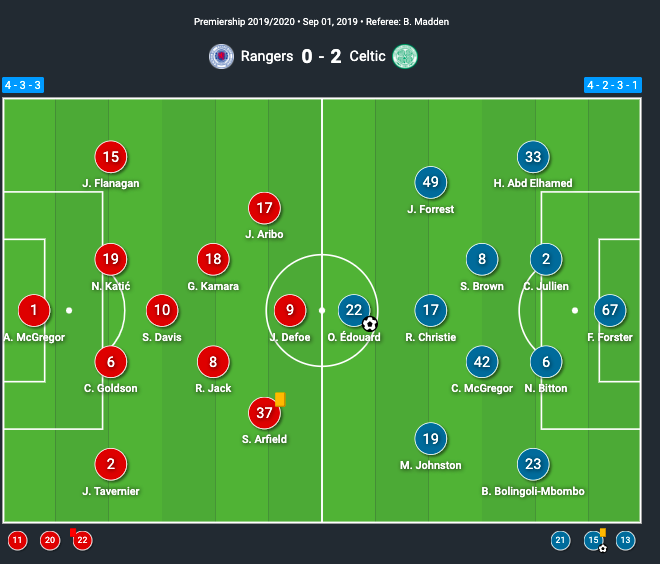
The autumn of 2019 was Rangers strongest period of season 19/20 and a large part of this was due to the centre back partnership between Connor Goldson and Filip Helander. Niko Katic had been Goldson’s most regular partner in Gerrard’s first season and whilst Katic is an outstanding siege defender, his technical ability on the ball is not quite as mature. This was no more apparent than in the opening Old Firm game of the 19/20 season. Rangers went into this match in good form and high on confidence but it was Celtic who would win the tactical battle and take the victory. Celtic’s pressing strategy in this game centred on taking advantage of Borna Barisic’s injury in the Warsaw game and targeting the left hand side of the Rangers defence. Celtic cut off passing angles and pressed in a way that left Rangers with no option but to attempt to build play down their left hand side with Jon Flanagan and Niko Katic, both right footed and both arguably the two least technical players in the team.
Filip Helander wasn’t chosen for this game despite joining from Bologna and performing well in his opening few games, but it was clear that the signing indicated that the management team had identified an opportunity to give more flexibility in that area of the pitch. As a natural left footer, Helander provided a balance to the defence that just wasn’t possible with right footed Katic. With Borna Barisic in particular being so left footed, every build of play from that side felt clunky and imperfect. Instantly, Helander was able to open that left hand side and provide Rangers with yet another dimension and avenue to progress the ball quickly through the lines.
This was borne out later in the season in the build up to Alfredo Morelos’ outstanding goal in the 1-1 draw with Porto. From his position at left centre back, Helander calmly receives a pass from Goldson and with one touch pings a low, quick vertical ball through the Porto midfield line of pressure to Ryan Kent. A quick round the corner flick from Kent finds Barisic free on the flank and another one touch cross is delivered inch perfectly to Morelos to lash home the equaliser.
Not the most difficult of passes for Helander, but equally not one that any other Rangers centre back of the 8 years previous would have been equipped to make. More importantly than his ball progression, Helander’s positional sense and defensive ability provided a calming influence to the back four that would provide the base as this team started to evolve into a dangerous attacking unit at European level.
Game 3: Full Back Playmakers, two of them – Feyenoord 19th September 2019
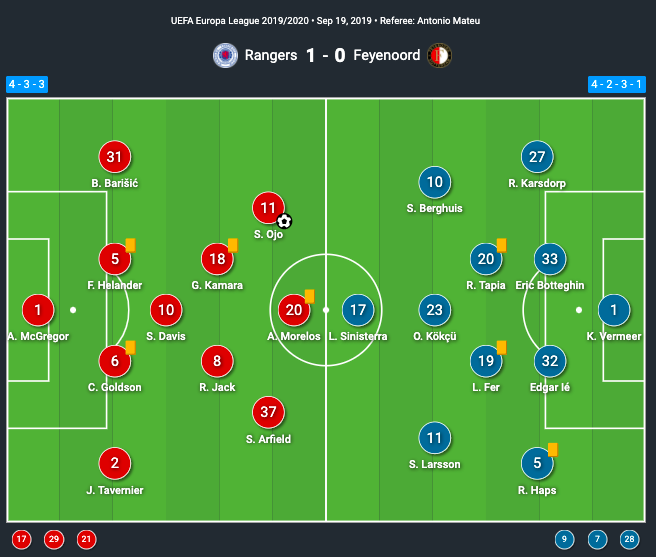
It’s widely acknowledged that Borna Barisic’s arrival as a Rangers player came with his superb free kick against St Mirren. As good as that goal was, that’s not quite the case. An injury in the very next game against Legia Warsaw – where he had looked timid and unsure in possession throughout – resulted in Barisic missing the 2-0 loss to Celtic at Ibrox detailed above. As mentioned, Celtic’s tactical plan for this game was predicated on allowing Niko Katic and Jon Flanagan possession of the ball to limit Rangers build up.
It was clear Rangers needed Barisic fully fit and firing ASAP. His first game back from injury came in the 1-0 win against Feyenoord, a significant match for a number of reasons. This was the first big European game where Rangers really took the fight to a quality opposition. It was also the first appearance on the European stage of Rangers twin 10’s and the midfield axis of Jack-Davis-Kamara.
It would undeniably be the arrival of Barisic as an attacking force that would bring the most benefit to the team. Having the option of attacking down either wing is something Rangers have utilised to maximum effect in the 18 months since, electing to use both players in very different ways. Barisic is more of a traditional full back, preferring to swing inch perfect crosses in from deep whereas Tavernier gets himself much more involved in link up play and ball progression on the opposite flank.
Since this game in mid-September 2019, Barisic hasn’t looked back and together with Tavernier they have both been the outstanding creative forces in the Scottish game. In the 76 games since, this Feyenoord game they have been responsible for a total of 62 goals (20 goals, 42 assists) which tells its own story about how important their contribution has been.
Game 4: Beating the low block – Aberdeen 5-0 28th September 2019
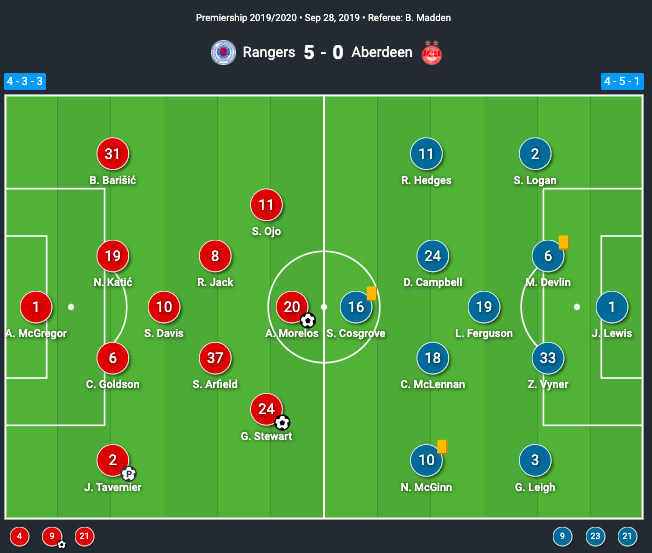
Rangers would only drop seven points in their first 19 league fixtures heading into the January winter break. Particularly in the autumn, the team were playing with a verve and vigour that just wasn’t present the season before. Consistency was still an issue, with that six game winning streak not in danger of being threatened in the entirety of the 19/20 season.
Rangers were a cohesive, well structured team set up perfectly to deal with most challenges at home and abroad, but were still quite reactive throughout most matches and generally needed to play with a high intensity and maximum effort to achieve victories.
One remaining problem was also not fully solved yet. How to beat the blow block.
In this quirky little corner of the footballing universe, Rangers (and Celtic) face a number of unique challenges. It is not unknown for opposition teams to set up in 6-3-1 or 5-5-0 formations set up solely to stop Rangers playing with little to no thought to any attacking intent. The more run of the mill games were where Rangers were coming unstuck, not quite having the guile and craft to break down these deep defences. A key issue here, was that much celebrated midfield three of Steven Davis, Ryan Jack and Glen Kamara. Whilst each player was positionally and technically excellent, all three were very similar and offered limited attacking threat. Finding a way to introduce a box to box midfielder who could get beyond the forward three would be crucial to Rangers fortunes.
Rangers record against Aberdeen had been terrible for a number of years culminating in a disastrous 2-0 home loss in the Quarter Final of the 2019 Scottish Cup. But in September of the same year, Rangers showcased how they planned to deal with these type of games and these type of opponents.
The key player in this game was Scott Arfield, now back playing in central midfield and performing very well. He had filled in as a number ten earlier in the season due to the late arrival and subsequent injury to Ryan Kent but it would be central midfield he would go on to make his own.
In this game, Arfield displayed everything Rangers had been lacking with his direct running and clever link up play. He combined very well with Greg Stewart – in a rare start – in particular and provided a cutting edge from central midfield that had been largely absent. Rangers short, sharp passing game and rotational movement was a joy to watch, especially when coupled with Aberdeen’s version of extreme man marking. Arfield’s guile and the forward three’s movement created opening after opening and allowed Rangers to take advantage to full effect.
Game 5: Rangers ‘Big Game’ Midfield Three evolution – Porto 1 – 1 Rangers 24th October 2019

This solid midfield structure would be taken onto another level in season 19/20 with the big game midfield three of Steven Davis, Ryan Jack and Glen Kamara performing successfully at home and abroad This trio actually debuted for the first time in the same Hearts game back in April 2019 as the ‘twin 10’s’. Quite an important 90 minutes for the tactical evolution of this team.
It was around this time, several comparisons would start to be drawn with Liverpool’s tactical set up under Jurgen Klopp. This flat midfield three was very reminiscent of the Liverpool midfield three and also allowed Rangers to experiment with those three forwards mentioned earlier staying further forward and not being tasked with tracking back.
As mentioned above, Rangers now had two flying full backs and three central attackers with limited defensive responsibilities so something had to give. The next evolution of the midfield three would soon become apparent almost immediately following Rangers late defensive capitulation away to Young Boys in the Europa League group stages. There would be no repeat in their next European game away in Oporto, with Rangers producing arguably their finest 90 minutes of the Gerrard era to that point.
A key facet of this victory was a small but significant tweak to the central midfield set up resulting in Glen Kamara and Ryan Jack being asked to cover space laterally rather than vertically. In short this meant that when Borna Barisic attacked, it was the primary function of Kamara to shuffle over and ensure Rangers had the appropriate level of defensive cover. The same was true on the right side, with Jack tasked with dropping in during James Tavernier’s frequent forays into the attack.
This now provided Rangers with a solid defensive base in both offensive and defensive phases of play and with three central attackers supported by the two attacking full backs, were generally well set up as an attacking force.
Game 6: Finding a way – Rangers 3 -2 Braga 20th February 2020

Tactics and formation mean different things to different people. For some, it is simply how the teams are displayed on TV prior to to the games and for others its the single most important part of the modern game. The truth – as always – lies somewhere in the middle. Every tactical set up is imperfect. Even the great Barcelona teams of the recent past were eventually figured out, that’s part of what makes football so captivating.
With that being said there are not many times in Steven Gerrard’s 152 games in charge where Rangers have been tactically outclassed by any team. At half time on 20th February 2020, however, it was only natural to believe that this would be one of them. Rangers trailed by two goals at home to a wonderful performance of aggressive pressing, pace and precision from Braga.
A regular criticism levied at the management had been how wedded Rangers were to a singular style of play. As outlined above, this is a little unfair as whilst Rangers shape is nominally always the same, there were clear and obvious signs of progression throughout the first two seasons. Another grumble was how reticent Gerrard – fairly cautious in his tactial set up to date as a manager – was to making substitutions to change games, fearing that this may upset the structure and rhythm of the team.
Something had to give in this game if Rangers wanted to progress to the next round of the Europa League. Rangers didn’t start the second half well, conceding a long range goal from Fransergio and but for a smart Allan McGregor save, could have found themselves dead and buried before the hour mark. The introduction of Joe Aribo for Glen Kamara was a signal that Rangers wanted more attacking threat from their midfield, but it was actually the substitution of Borna Barisic who was replaced by Greg Stewart that would prove indirectly crucial. Ianis Hagi continued his excellent start to his Rangers career with a fantastic finish after cutting in on his left foot from the flank to give Rangers hope, but that substitution and Aribo being redeployed as an auxiliary left back was the key to this victory. The equalising goal came from Aribo and showcased everything this fantastically gifted footballer has to offer.
With fifteen minutes to go Aribo picks the ball up in on the left flank, beats two men and exchanges a one two with Hagi. With only Stewart ahead of him and five Braga players in his way, the expectation was that the ball would be recycled back and Rangers would try again. Instead, Aribo decided to inexplicably slalom his way through the entire Braga defence before slotting the ball into the bottom left corner to draw Rangers level. A Ianis Hagi free kick five minutes later completed the comeback and gave Rangers a crucial edge ahead of the away leg which they also won to progress to the next round.
This game was a tactical masterclass for the first 60 minutes…but not from Rangers. Rangers dragged themselves back into the tie by tweaking their tactical approach and found a different way – any way – to win the game. That flexibility and sheer desire to get over the line when things aren’t going your way was another crucial milestone in the development of this team.
Over those first two seasons of Gerrard’s reign, Rangers improved immeasurably across all areas of football ranging from player quality to tactical philosophy, but Rangers teams are judged on silverware and this had not arrived. Despite the victory against Braga, Rangers started 2020 poorly and would showcase the same old problems with consistency. As the world headed into lockdown and football was paused, many wondered whether this team would be capable of delivering what the fans so desperately craved.
This article will be split into two parts with the second part focusing on Rangers tactical performance in season 20/21. This will be released following the conclusion of the current season.



